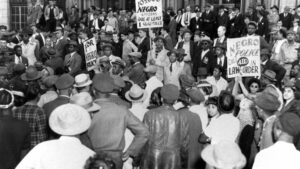
Revolutionary War in Georgia
Discover the shifting alliances and political rivalries that shaped the Revolutionary War in Georgia.
Austin Dabney

During the Revolutionary War, enslaved African American Austin Dabney made history as a private in the Georgia militia, serving in place of his enslaver as an artilleryman. He is believed to be the only African American to fight in the Battle of Kettle Creek, where he was wounded. After the war Dabney became the only African American to receive land grants in the Georgia Land Lottery in recognition of his service.
Sample Primary Resources
Digital Library of Georgia
Cherokee Indians

The Cherokee people were one of the major Native American tribes in the Southeast and played a significant role in the American Revolution. Divided over whether to support the British or remain neutral, many Cherokees sided with the British in response to the threat of American expansion and fought against the southern states.
Sample Primary Sources
Digital Library of Georgia
Creek Indians

Until the 1760s, the Muscogee (Creek) people outnumbered both European colonists and enslaved Africans in Georgia. Through deerskin trading, the Creek Nation maintained relations with colonists for many years. This relationship began to crumble during the Revolutionary Era, however, as dwindling white-tailed deer populations led to the collapse of the deerskin trade. Colonists increasingly viewed the Creeks less as partners in trade than as barriers to expanding plantation slavery. By the 1800s the Muscogee were removed and forced to cede all their land in Georgia.
Sample Primary Sources
Digital Library of Georgia
James Oglethorpe

James Oglethorpe was the driving force behind the creation of the colony of Georgia, serving as one of its original Trustees and the architect of Savannah’s city plan. Although he held no official office outside of his service as a Trustee, Oglethorpe is often regarded as Georgia’s first governor, working tirelessly to establish the colony and to defend Georgia against Spanish troops. Legend has it that when asked to command a British force during the American Revolution, Oglethorpe declined the offer.
Sample Primary Sources
Digital Library of Georgia
Mary Musgrove

As an expert in the arts of trade and negotiation, Mary Musgrove—also known as Coosaponakeesa among Muscogee (Creek) people—formed a crucial link between colonists and Native Americans in Georgia at the time of Savannah’s founding. As the daughter of a European tradesman and a Muscogee mother, Musgrove was well-versed in the language and customs of two different worlds. She used her knowledge to foster good relations between the two communities and to boost her own status in an ever-changing society.
Sample Primary Resources
Digital Library of Georgia
Trustee Georgia

Georgia’s charter, signed on April 21, 1732, officially established Georgia as a colony. The governing board, known as the Trust, was made up of Trustees who governed the colony from England. This period, called Trustee Georgia, lasted from 1732 to 1752, shaping the colony’s early years under distant leadership.
Sample Primary Sources
Digital Library of Georgia
Revolutionary War in Georgia

Georgia’s part in the Revolution was shaped by internal divisions between loyalists and revolutionaries. While coastal elites leaned toward independence, many backcountry settlers remained loyal to Britain. The colony was slow to join the revolutionary cause but eventually sent a delegate, Lyman Hall, to the second Continental Congress in Philadelphia in 1775. Yet British forces took control of Savannah in 1779 and attempts to retake the city failed. Overall, the war in Georgia was marked by shifting alliances, guerrilla warfare, and political instability.
Sample Primary Sources
Digital Library of Georgia
Royal Georgia

Royal Georgia refers to the period between the end of Trustee Georgia, or remote British rule, and the signing of the Declaration of Independence in 1776. Beginning in 1752, England’s Board of Trade was given the power to appoint Georgia’s governor and council members. During this time, Georgia was led by three governors: John Reynolds, Henry Ellis, and James Wright, each serving four-year terms, as the colony’s political landscape shifted under royal control.
Sample Primary Sources
Digital Library of Georgia
Savannah City Plan

Designed by founder James Oglethorpe in 1733, Savannah’s City Plan marked an important departure in the history of urban planning. The plan consisted of interconnected neighborhoods divided by eight-block increments, leading to local wards. It also featured multiple city squares divided by pedestrian streets connected to spaces for activities such as gardening and farming alongside more traditional city life. The design, which remains largely in tact today, continues to influence contemporary urban planners and has inspired numerous settlements and city developments throughout the twentieth century.
Sample Primary Sources
Digital Library of Georgia



